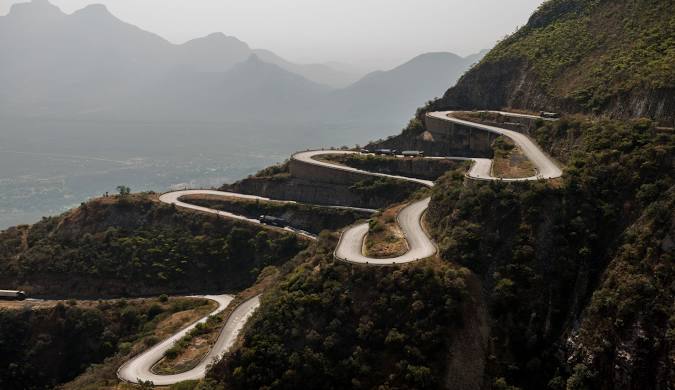Serra da Leba , Angola
🏞️ Explore Serra da Leba: Angola’s Most Breathtaking Road
Serra da Leba is one of Angola’s most iconic natural wonders, famous for its jaw-dropping mountain road with dramatic hairpin bends and panoramic views that seem to stretch forever.
It’s not just a destination — it’s a journey you’ll never forget.
🌄 Why Visit Serra da Leba?
-
The Legendary Hairpin Road
The Serra da Leba Pass features a zigzagging road with over 30 tight curves carved into the steep mountainside — a true engineering marvel!
Tip: The best photo spot is at the top viewpoint where you can see the entire snaking road below. -
Spectacular Views
From the viewpoint (Miradouro da Serra da Leba), you’ll be treated to sweeping landscapes: misty mountains, deep valleys, and lush forests merging into the endless horizon. -
Photographer’s Dream
Sunrise and sunset light up the mountains in golden hues — creating epic, Instagram-worthy shots. -
Cooler Climate
Because of the altitude, Serra da Leba has refreshing, crisp air — a welcome break from the coastal heat.
📍 Location & How to Get There
-
Location: Between the provinces of Huíla and Namibe, southern Angola.
-
Closest City: Lubango (about 30–45 minutes’ drive away).
-
How to Visit:
-
Car rental (4x4 recommended for full exploration)
-
Guided tours departing from Lubango
-
Tip: Many travelers combine Serra da Leba with a visit to Tundavala Gap (Fenda da Tundavala) for a full day of nature wonders!
🧭 What Else to Do Around Serra da Leba
-
Tundavala Gap (Fenda da Tundavala):
A mind-blowing cliff that drops almost 1,000 meters — pure adventure and stunning views. -
Lubango City Tour:
Visit the Christ the King statue (Cristo Rei), colonial buildings, and lively local markets. -
Namibe Desert:
Explore vast desert landscapes and see the rare Welwitschia plants — some are over 1,000 years old!
📅 Best Time to Visit
-
May to September (Dry Season): Clear skies, cooler temperatures, and safer driving conditions.
-
October to April (Rainy Season): Roads may be slippery; mornings often foggy (still beautiful for moody photos though!).
🎒 Travel Tips for Serra da Leba
-
Drive carefully: Sharp curves require slow speeds.
-
Bring layers: Weather can be cool and windy at the top.
-
Charge your camera: You’ll want lots of photos!
-
Visit early: Fewer crowds and better light conditions for photos.
-
Stay alert for trucks: This is a working road, and large vehicles use it daily.
-
🏞️ Ultimate Travel Guide to Serra da Leba, Angola
🏔️ The Story Behind Serra da Leba
-
Historical Background:
The road was built during the Portuguese colonial period in the 1970s.
It was engineered to connect Lubango (Huíla province) with the coastal town of Namibe, which was critical for trade and transport.
Today, it remains a vital link and a proud symbol of Angolan engineering. -
Origin of the Name:
Serra means "mountain range" in Portuguese, and Leba refers to a local tribal group that originally inhabited the surrounding areas.
🚗 Road Details: What Makes It Special?
-
Length of the Pass: About 20 kilometers (12.4 miles) of dramatic switchbacks.
-
Elevation Change: Rises over 1,800 meters (5,900 feet) in elevation!
-
Road Type: Mostly paved but narrow and very winding.
-
Driving Experience:
-
Expect sharp hairpin bends.
-
Some parts have guardrails, but caution is needed — especially when it’s foggy.
-
Watch for trucks, buses, and cyclists.
-
🌿 The Nature Around Serra da Leba
-
Vegetation:
-
High altitudes: Grassy hills, eucalyptus forests, and rocky outcrops.
-
Lower slopes: Semi-arid savannah landscapes transitioning toward Namibe’s desert.
-
-
Wildlife (Spotting is Rare but Possible):
-
Birds of prey (hawks, eagles) soaring over cliffs
-
Small antelope species
-
Chameleons and reptiles hidden in the grasses
-
📸 Best Photography Spots
-
Miradouro da Serra da Leba (Main Viewpoint):
Stunning panoramic view of the full zigzag road.
Sunrise and sunset create magical lighting for dramatic photos. -
Along the Curves:
Stop at safe pullouts to capture cars winding down the bends — especially beautiful in morning mist. -
Top of the Pass:
Wide landscapes with changing colors depending on the time of day.
Pro tip: Bring a drone if possible — the aerial shots of the curves are world-class!
🛏️ Where to Stay Nearby
-
Lubango City Hotels:
-
Pululukwa Resort: Luxury eco-lodge with incredible views.
-
Hotel Serra da Chela: Good mid-range option, centrally located.
-
-
Camping Adventure:
Some adventurous travelers camp at viewpoints near Tundavala Gap (but only recommended with guides and good preparation!).
🍽️ Food & Local Eats
After a day of mountain exploration:
-
Try traditional Angolan dishes like funge (maize porridge) and grilled meats.
-
Fresh tropical fruits like mangoes, bananas, and papayas are sold along the roadside.
In Lubango, you'll find a mix of local eateries and some Portuguese-influenced cafes.
🧭 Recommended Day Itinerary
Time Activity 7:00 AM Depart Lubango (early to catch sunrise) 8:00 AM Arrive at Serra da Leba viewpoint 9:00 AM Drive carefully down the pass 11:00 AM Visit Namibe town or nearby beaches 1:00 PM Lunch in Namibe (seafood recommended!) 3:00 PM Return drive to Lubango (optional stops)
📋 Updated Meta Title:
Serra da Leba Angola: Epic Road Trip, Photography & Travel Guide 2025
🌟 Updated Rating:
9.5/10
✅ Reason for Upgrade:
Once you combine natural beauty, historical meaning, adventure driving, and proximity to other attractions (like Namibe and Tundavala), Serra da Leba truly becomes an unforgettable highlight for travelers.
✨ Fun Extra Fact
Locals say that if you drive the Serra da Leba curves without stopping, you’ll "gain the blessing of the mountain spirits" — a nod to the ancient beliefs tied to these sacred hills.
-


